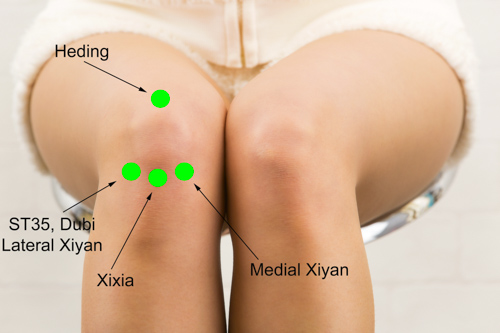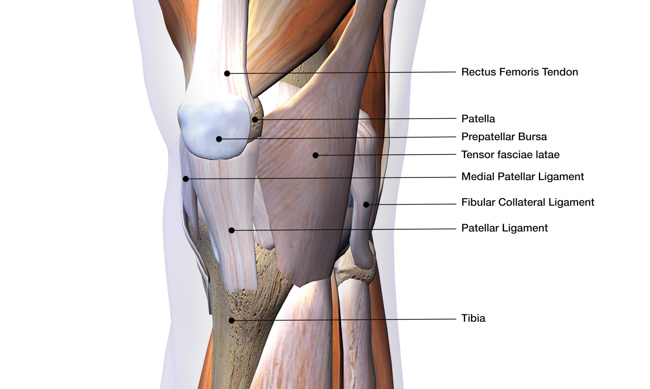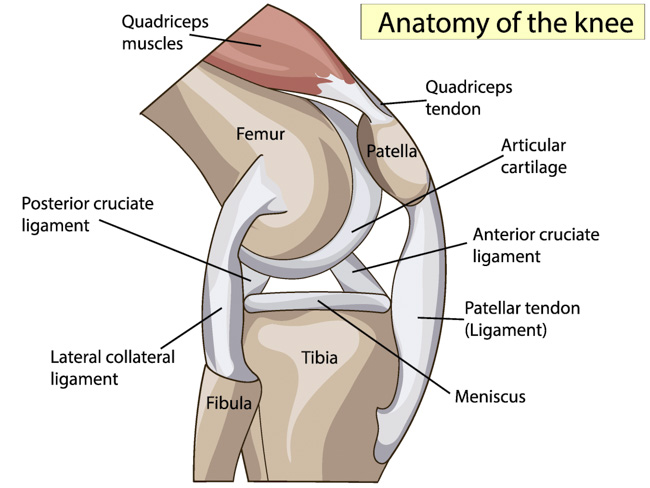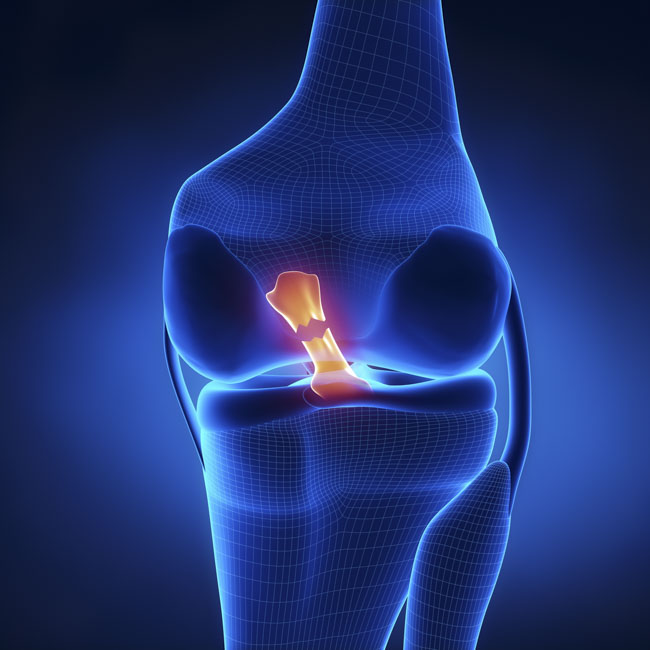Acupuncture For Knee Pain
Sample of Course Materials

Sample #1
Bursa
The knee has several bursae (fluid-filled sacs or cavities, especially ones countering friction at a joint)...

More in course materials…
Sample #2
ACL
Anterior cruciate ligament or ACL (an intracapsular ligament)—The ACL prevents the knee from hyperextending and the tibia from sliding anteriorly. ACL injuries often occur during non-contact sporting activities involving rotation of the knee (some experts believe internal rotation may create greater risk). However, injuries can occur from any activity that stretches the ligament beyond its normal capacity, particularly while the leg is in a valgus position (internally rotated tibia). The trauma can result in...


More in course materials…
Sample #3
Steroid Injections
Dr. Kirstie Saltsman, Ph.D. published findings on the National Institute of Arthritis and Musculoskeletal and Skin Diseases website:
- Among people with osteoarthritic knees, repeated steroid injections over two years brought no long-term improvement in reducing pain, according to a study funded in part by the NIH’s National Institute of Arthritis and Musculoskeletal and Skin Diseases (NIAMS). Rather than showing any benefit, the results revealed that the injections sped the loss of the cartilage that cushions the knee joint. The study appeared in the Journal of the American Medical Association (JAMA).
- “Use of corticosteroid injections to treat knee OA is based on the medicine’s capacity to reduce inflammation, but corticosteroids have also been reported to have destructive effects on cartilage,” said Dr. McAlindon. “We now know that these injections bring no long-term benefit, and may, in fact, do more harm than good by accelerating damage to the cartilage.” [1]
The aforementioned study referenced by Dr. Saltsman that cautions against the long-term use of corticosteroid injections concludes the following:
- Among patients with symptomatic knee osteoarthritis, 2 years of intra-articular triamcinolone [intermediate-acting synthetic glucocorticoid], compared with intra-articular saline, resulted in significantly greater cartilage volume loss and no significant difference in knee pain. These findings do not support this treatment for patients with symptomatic knee osteoarthritis. [2]
NIH and Acupuncture
A division of the National Institutes of Health, the National Center for Complementary and Integrative Health, notes the following:
- A landmark study has shown that acupuncture provides pain relief and improves function for people with osteoarthritis of the knee and serves as an effective complement to standard care. The study, the largest Phase III clinical trial of acupuncture for knee osteoarthritis, was…
References:
1. niams.nih.gov/newsroom/spotlight-on-research/long-term-benefit-steroid-injections-knee-osteoarthritis-challenged
2. McAlindon, Timothy E., Michael P. LaValley, William F. Harvey, Lori Lyn Price, Jeffrey B. Driban, Ming Zhang, and Robert J. Ward. "Effect of intra-articular triamcinolone vs saline on knee cartilage volume and pain in patients with knee osteoarthritis: a randomized clinical trial." Jama 317, no. 19 (2017): 1967-1975.
More in course materials…
Sample #4
Chinese Medicine
Knee pain may be due to excess or deficient etiologies. Rheumatoid arthritis, osteoarthritis, and trauma are common causes. Invasion of external pathogenic factors is a risk factor for knee pain.
Cold and Damp
Environmental risks include dampness and cold. Patients exposed to these conditions may experience wind, cold, and damp attacking the joints, especially when the wei qi (defensive qi) is deficient. Cold and damp exogenous pernicious influences lead to qi and blood stasis, thereby causing knee inflammation and pain. For cold and dampness, patients present with knee pain, coldness of the limbs, and the pain is alleviate by warmth. The pulse is deep, tight, or slow. The tongue is pale or purple.
Qi and Blood Deficiency
Qi and blood deficiency may result in knee pain.Patients often present with bilateral knee pain that worsens throughout the day, weakness of the knees, pallor, dizziness, and palpitations. Risk factors include aging and chronic illness. Deficiency precipitates invasion of external pernicious influences (including wind, cold, and dampness) and subsequent…
More in course materials…
Sample #5
Acupuncture Points
The following are common acupuncture points used for the treatment of knee disorders.
Xixia (M-LE-15, Below Knee, Hsi Hsia)
This point is at the patellar ligament at the lower border of the patella. The point is below the center of the inferior margin of the patella. Needle insertion is approximately 1–1.5 cun, perpendicularly. Pressing on the point prior to needling often helps to prevent patient discomfort.
This acupoint is very effective for the treatment of many knees disorders, including disorders of the soft tissues of the knee region.
- Xixia is indicated for the treatment of knee arthralgia (joint pain), patellar ligament strains, and arthritis.
- This acupoint pairs with medial and lateral Xiyan (MN-LE-16) for the treatment of knee pain, arthritis, ACL and meniscus injuries, and many soft tissue injuries.
- For arthritis of the knee, Xixia may be combined with Xiyan (MN-LE-16), Heding (M-LE-27), ST36 (Zusanli), GB34 (Yanglingquan), and SP9 (Yinlingquan).
Classic Three Point Combination
The three point combination of medial and lateral Xiyan with Xixia is a powerful and effective treatment for knee disorders. Xiyan is also commonly used with Heding….

More acupuncture points in the course materials…
Sample #6
Osteoarthritis and Cartilage Repair Research
Acupuncture stimulates cartilage repair for patients with knee osteoarthritis. [1] Using MRIs, researchers have quantified the therapeutic effects of acupuncture. Within four weeks, acupuncture successfully improves the condition of cartilage in the anterior medial and lateral tibial regions of the knee. In addition, Western Ontario and McMaster Universities Osteoarthritis Index (WOMAC) scores document that acupuncture reduces pain and stiffness levels while simultaneously improving physical function.
In a controlled trial (Zhang et al.), acupuncture was compared with the therapeutic benefits of physical therapy. The MRIs demonstrate that acupuncture improves cartilage in the knee region. Physical therapy did not stimulate cartilage repair. Pain, stiffness, and physical functioning improved with both therapies. However, acupuncture significantly outperformed physical therapy across all three WOMAC indices (pain, stiffness, and physical functioning).
MRI Results and Acupuncture Points
The researchers used T2 MRIs (magnetic resonance imaging) to measure changes in knee cartilage integrity…
Reference:
1. Zhang, Yan, Fei Bao, Yan Wang, and Zhihong Wu. "Influence of acupuncture in treatment of knee osteoarthritis and cartilage repairing." American journal of translational research 8, no. 9 (2016): 3995.
More research in the course materials...

